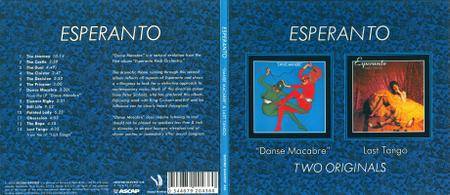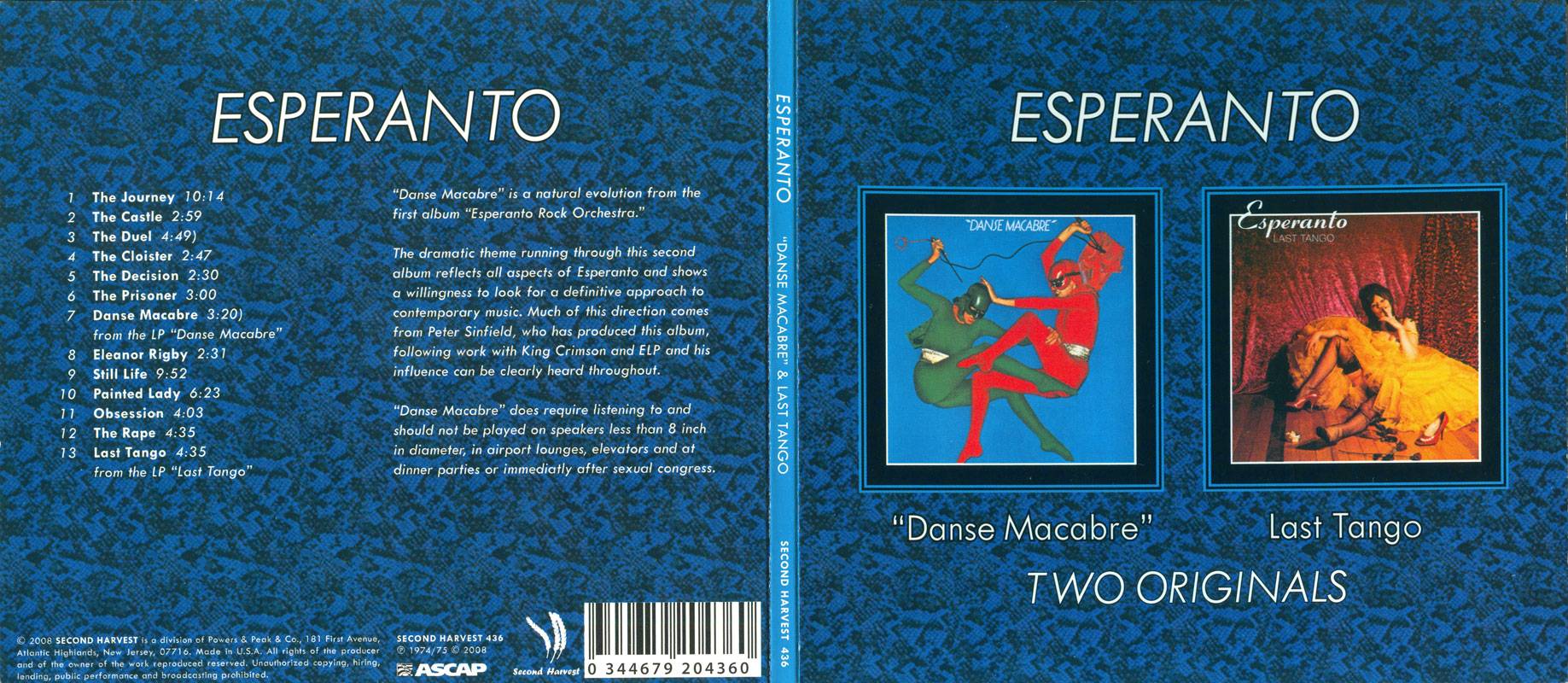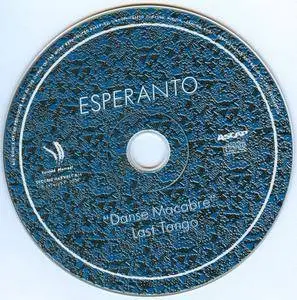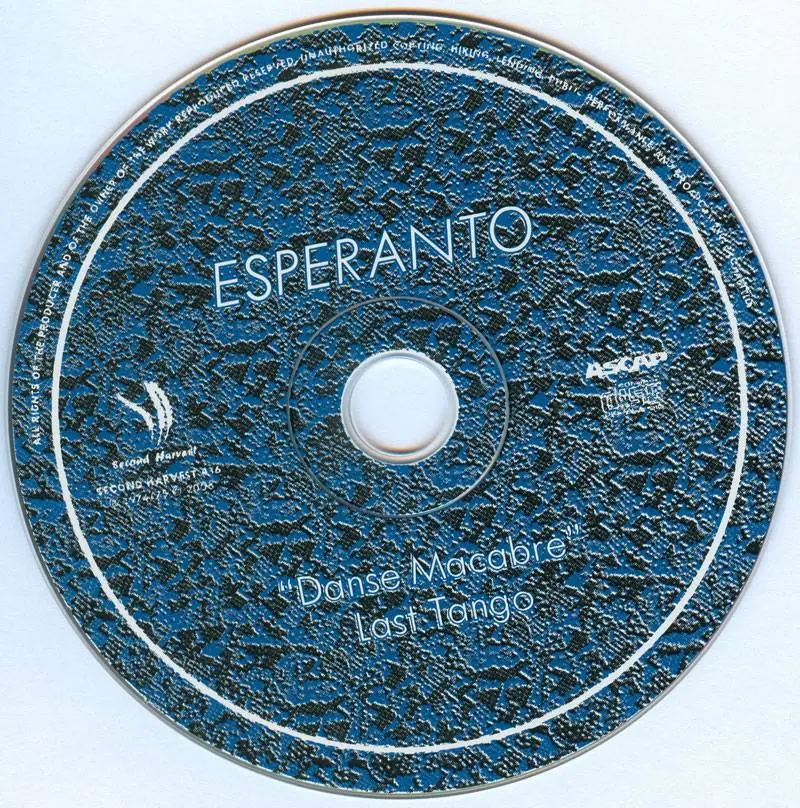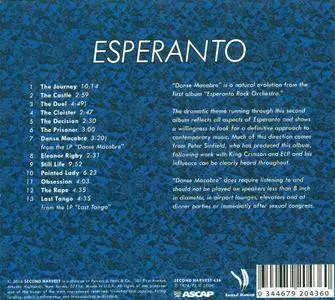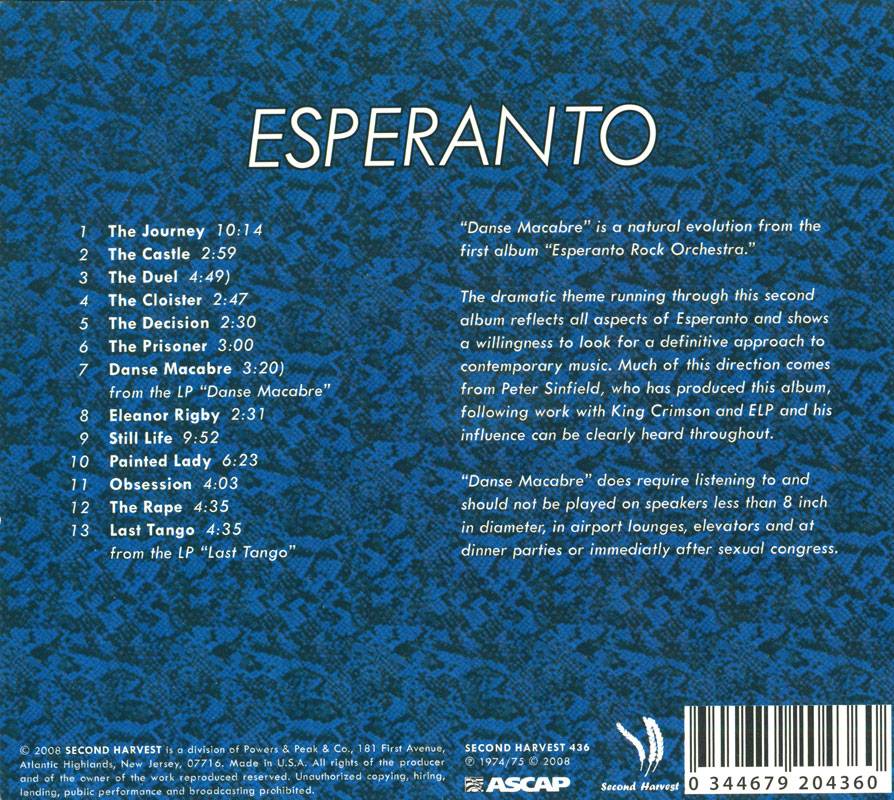Esperanto - Danse Macabre `74 & Last Tango `75 (2008)
EAC | Flac(Image) + Cue + Log & MP3 CBR 320Kbps
Second Harvest, 436 | ~ 498 or 190 Mb | Scans(jpg) -> 44 Mb
Progressive Rock, Art Rock
EAC | Flac(Image) + Cue + Log & MP3 CBR 320Kbps
Second Harvest, 436 | ~ 498 or 190 Mb | Scans(jpg) -> 44 Mb
Progressive Rock, Art Rock
Esperanto is a language invented in 1887 by Zamenhof, who combined bits of various Romance language to make what he hoped would become a vehicle of universal communication. The Belgo-English band of the same name at the beginning of the 70s had a short but intense career and produced an extremely varied musical repertoire thanks to the many different nationalities, origins and outlooks of its members.
It all started at the end of '71 when the Belgian violinist Raymond Vincent, leader of the Wallace Collection wanted to embark on a more adventurous musical endeavour (in spite of his surprising predilection for hard rock) after his band had broken up. After playing for a short period with Dany Lademancher and Roger Wollaert (who had left Kleptomania), then with Dirk Bogaert (of Waterloo), he got in touch with Bruno Libert who was completing his musicology studies and playing piano every night in Brussel's theatres that were putting on "off Broadway" musicals, which were quite fashionable at the time. Raymond told Bruno about his new project and showed him some musical ideas. He also played him a promotional album, Metronomics, that he had written for an advertising campaign. The two musicians agreed to launch the project and started to look for other musicians. They discovered the Malisan brothers, two Italo-Belgians of the Mons area: Gino, bass player and Tony, drummer. They started to rehearse in the back room of a small cafe, wrote a series of new numbers and recorded a first demo-tape at "Cathy" studio in the Brabant Wallon region, owned at the time by Marc Aryan (Belgian singer successful at the beginning of the 70s).
The four musicians took their demo to England, where they met David Mackay who had produced the Wallace Collection and The New Seekers and later produced part of Esperanto's first album. David was interested by the project and agreed to recruit more musicians in order to strengthen the line-up which was quite limited on the first demo (violin, piano and Hammond organ, bass and drums). Soon, he contacted Glenn Shorrock, an Australian singer who was living in London at the time and had left his group, the Twilights. David also played a series of records from his collection to the musicians to try to find female singers. Raymond and Bruno were immediately convinced that Cliff Richard's trio of backing singers would fit the bill. David set up an appointment with Joy Yates, Janice Slater and Bridget Dudoit (who had released a record under the name of Bones) and easily convinced them to join the group as they were quite enthusiastic. The band was also looking for a guitarist and more string players in order to form a quartet. David Mackay found Brian Holloway, an Australian guitar player. As he regularly conducted recording sessions in London studios, it was also easy for David to assemble a modern-sounding string section, unlike Belgian strings which tended to sound more classical. A second violin (Godfrey Salmon), a viola (Tony Harris) and a cello (Timothy Kraemer) joined Esperanto and the first line-up was ready.
The producer rented a farm for several weeks in Cornwall and the twelve musicians, some of whom barely knew each other, or having just met, began to rehearse. The results were excellent. The group then moved to a farm in Houyet, in Belgium, to further work on the repertoire. They went back to London, and David Mackay took everybody to Morgan studios to record the first album. Several new pieces were written, among which "Black Widow" and "Publicity", which would be released as a single but was not included on the first album. After the recording, the producer went in search of a contract. Polydor was quite enthusiastic about the music but, because of a small disagreement on contract details, the negotiations failed and the contract was never signed. In fact Polydor did invest in another group which had quite a career: Slade. Finally, after months of prospection and a meeting with Herb Alpert and Jerry Moss, a contract was finally signed for three albums with A&M. The first album "Esperanto Rock Orchestra" was released in 1973.
Contacts were then established with tour managers and Esperanto began a series of concerts, first in England, as supporting act for Sha na na (also with A&M at the time), playing gigs at the Roudhouse, the Shaw Theatre, the Rainbow, the Queen Elizabeth Hall in London, but also in Newcastle, Manchester, Liverpool, etc. The tour was difficult to handle for the band, as the public of Sha na na was not really that of Esperanto and, in spite of an acerbic article published in the famous "Melody Maker", which called them "pseudo-hippies", it went on in Europe, this time with the Strawbs The band also made a series of live recordings for the RAI in Rome, Naples and Turin which were broadcast on the Italian television. Esperanto did however not know the sales figures of their album and had to rely on the reactions of the public to evaluate their success.
Back in England, the twelve musicians met up again, this time in a castle in Wales, and started to prepare the next album. The band always had to meet in farms and castles because of the large number of musicians and of the logistic difficulties of gathering the whole crowd in London. The Welsh castle was of course haunted and its strange atmosphere permeated the music of what would become the band's second album (featuring a track called "The Castle"). After several weeks of rehearsals, the group recorded the first tapes and made an acetate which they presented to A&M, but the project was rejected by the record company. The situation then became difficult in the band, Glenn Shorrock, hit by nostalgia, decided to go back to Australia (he was well inspired as he later became very successful, notably in the United States, with Little River Band). A&M then asked Peter Sinfield (poet and song writer for King Crimson and ELP, and translator of Premiata Forniera Marconi's work - PFM) to produce the new album. Peter accepted and brought with him a new singer: Keith Christmas. Keith Christmas, who had a career as a solo singer afterwards, had a very different style and was more folk music oriented but he did take over from Glenn Shorrock as the front man. A new demo was then presented to A&M with different or rearranged pieces sang by Keith Christmas (on the acetate it was Glenn Shorrock - there are also unpublished pieces on this re-release). This time, A&M endorsed it. The three singers were still in the band but they were soon to leave, as would Brian Holloway, which explains why these four members of Esperanto are not (even though they play on the album) in the picture on the backsleeve of "Danse Macabre".
The second Esperanto record, "Danse Macabre", was released in 1974. If, on the first album, the band was obviously in search of its style, with pop, rock, classical and progressive influences, this new opus was much more homogenous, progressive, with a quite brooding atmosphere. The Welsh climate and the haunted castle had a great influence on the musicians and permeated Esperanto's music. It is worth noting that the album was released in France without the piece "Danse Macabre" as the Saint-Saëns copyright-owners refused to agree to its publication in that country. Peter Sinfield put so much energy into the making of this album that he later declared in an interview that he declined an offer to produce the first Supertramp album after the Esperanto experience.
Meanwhile, Esperanto's and its managers were preparing the next tour. Magma (another A&M artist, then little know in England) was to be supporting act. The tour took the two bands to most of the large universities in Britain. Again, Esperanto had no information on the album sales and were never paid any royalties for it by the label. They had to rely on the success of the tours to evaluate their impact on the public.
The line-up of Esperanto changed considerably for the third album. Keith Christmas had left for musical reasons and the band was looking for a more energetic front man. They met this time in London and published some ads in the music press, including in the Melody Maker (Genesis had recruited Steve Hackett through that channel). Esperanto auditioned and took on board their next singer Roger Meakin. His special vocal timbre made him an ideal partner for Kim Moore, female singer recruited in the same way, as their voices blended perfectly. The recording of the third album took place partly in London and partly at the famous chateau of Herouville near Paris where Jethro Tull, Elton John and many others recorded in the seventies. The album "Last Tango" was produced by Robin Geoffrey Cable (engineer and producer, notably for Queen, Genesis, Van Der Graaf Generator, Elton John and Carly Simon). It was released in 1975.
This time, the group seemed to have found its musical and personnel equilibrium and the tour which followed was very successful. They played at numerous famous festivals, including Reading, Newcastle and Bilzen among other engagements. The band also had a residence at the Marquee: an Esperanto concert was automatically programmed every 10 to 15 days in the famous London club for several months. The European tours were also quite successful, with memorable concerts at the Paradiso in Amsterdam and at the Festival de Montreux (Switzerland), with PFM.
Although the band seemed to have found its cruising speed and success was obviously on the horizon (they were still in complete ignorance of sales figures), A&M did not renew their contract. Esperanto band members were flabbergasted as they knew their music had real appeal, particularly given the growing success of their concerts. One of the negative factors was that situation in England in 1973-1974. Following the oil crises, the cost of vinyl manufacturing increased dramatically (note that the weight of records fell substantially) and labels were tending not to sign new artists or take any risks in this very unfavourable period. It was also the time of the miners' strike which lasted 9 months, paralysed the country and certainly did not contribute to improving the economic climate in England.
Esperanto was probably also a victim of it's formula as, even with a reduced line-up on the last album, it still had eight musicians and large technical staff who had to be housed, fed and watered. The cost of touring was very high and the technical problems linked to this sophisticated musical genre necessitated a lot of complex equipment for the era (difficulties of amplifying strings mixed with electronic instruments, etc.). The band was thus expensive to run and, as it is often the case, the law of immediate profits justified A&M's decision and overruled artistic quality.
This rupture marked the end of Esperanto. Nevertheless, they left as a heritage three remarkable albums, all different and full of qualities that this beautiful re-release will allow you to discover or rediscover. Some people compared Esperanto to a band like ELO because of the two violins and the cello but it is clear that Esperanto's repertoire is much more varied and inventive and that is has its roots in numerous influences, like its musicians.
We can only regret one thing: considering the talent of the musicians and their musical evolution, the group had probably not said its last word. Although several important prog rock bands had already produced their main opus back in 1975, the door was still open for many talented bands as it was the golden age of prog, which faded several years later.
Many years have passed and we should simply enjoy this re-release. After a decade of patient searching and efforts, you now have in your possession a rare testimony of the past. I hope you will have as much pleasure listening to it as the musicians had playing it in the early seventies.~ progarchives
Esperanto - Danse Macabre `74 & Last Tango `75 (2008):
Tracklist:
Danse Macabre 1974:
01. The Journey 10:15
02. The Castle 3:31
03. The Duel 7:06
04. The Cloister 5:29
05. The Decision 5:56
06. The Prisoner 7:20
07. Danse Macabre 2:00
Last Tango 1975:
08. Eleanor Rigby 7:43
09. Still Life 7:28
10. Painted Lady 3:28
11. Obsession 4:37
12. The Rape 12:07
13. Last Tango 3:30
Musicians:
Bass – Gino Malisan
Cello – Tim Kraemer
Drums – Tony Malisan
Guitar – Brian Holloway
Lead Vocals – Keith Christmas
Lyrics By, Backing Vocals – Glenn Shorrock
Piano, Organ, Synthesizer, Vibraphone, Harpsichord, Backing Vocals, Arranged By – Bruno Libert
Producer – Peter Sinfield
Viola – Tony Harris
Violin, Arranged By – Raymond Vincent
Violin, Tenor Vocals – Godfrey Salmon
Vocals – Brigette Du Doit
Exact Audio Copy V1.1 from 23. June 2015
Отчёт EAC об извлечении, выполненном 10. мая 2017, 17:54
Esperanto / Danse Macabre & Last Tango
Дисковод: ASUS DRW-24B3ST Adapter: 0 ID: 0
Режим чтения : Достоверность
Использование точного потока : Да
Отключение кэша аудио : Да
Использование указателей C2 : Нет
Коррекция смещения при чтении : 6
Способность читать области Lead-in и Lead-out : Нет
Заполнение пропущенных сэмплов тишиной : Да
Удаление блоков с тишиной в начале и конце : Нет
При вычислениях CRC использовались нулевые сэмплы : Да
Интерфейс : Установленный внешний ASPI-интерфейс
Выходной формат : Пользовательский кодировщик
Выбранный битрейт : 1024 kBit/s
Качество : Высокий
Добавление ID3-тега : Нет
Утилита сжатия : C:\Program Files (x86)\Exact Audio Copy\Flac\flac.exe
Дополнительные параметры : -V -8 -T "Date=%year%" -T "Genre=%genre%" %source%
TOC извлечённого CD
Трек | Старт | Длительность | Начальный сектор | Конечный сектор
––––––––––––––––––––––––––––––––––-
1 | 0:00.00 | 10:14.39 | 0 | 46088
2 | 10:14.39 | 3:30.67 | 46089 | 61905
3 | 13:45.31 | 7:06.00 | 61906 | 93855
4 | 20:51.31 | 5:28.73 | 93856 | 118528
5 | 26:20.29 | 5:56.15 | 118529 | 145243
6 | 32:16.44 | 7:20.05 | 145244 | 178248
7 | 39:36.49 | 1:59.45 | 178249 | 187218
8 | 41:36.19 | 7:42.72 | 187219 | 221940
9 | 49:19.16 | 7:28.33 | 221941 | 255573
10 | 56:47.49 | 3:28.12 | 255574 | 271185
11 | 60:15.61 | 4:36.50 | 271186 | 291935
12 | 64:52.36 | 12:06.52 | 291936 | 346437
13 | 76:59.13 | 3:30.35 | 346438 | 362222
Характеристики диапазона извлечения и сообщения об ошибках
Выбранный диапазон
Имя файла C:\Torrents - my\Esperanto - 1974-75 - Dance Macabre & Last Tango\Esperanto - Danse Macabre & Last Tango.wav
Пиковый уровень 98.9 %
Скорость извлечения 10.2 X
Качество диапазона 100.0 %
CRC теста A41D93E0
CRC копии A41D93E0
Копирование… OK
Ошибок не произошло
AccurateRip: сводка
Трек 1 : извлечено точно (доверие 4) [BF5BA998] (AR v2)
Трек 2 : извлечено точно (доверие 4) [49ACF0EC] (AR v2)
Трек 3 : извлечено точно (доверие 4) [C0B29BBE] (AR v2)
Трек 4 : извлечено точно (доверие 4) [598910F0] (AR v2)
Трек 5 : извлечено точно (доверие 4) [F4447015] (AR v2)
Трек 6 : извлечено точно (доверие 4) [EB166ED7] (AR v2)
Трек 7 : извлечено точно (доверие 4) [7BA4C7AC] (AR v2)
Трек 8 : извлечено точно (доверие 4) [549D2ACE] (AR v2)
Трек 9 : извлечено точно (доверие 4) [E5CBFE34] (AR v2)
Трек 10 : извлечено точно (доверие 4) [25C77537] (AR v2)
Трек 11 : извлечено точно (доверие 4) [BEDCAEFA] (AR v2)
Трек 12 : извлечено точно (доверие 4) [8F2E2B65] (AR v2)
Трек 13 : извлечено точно (доверие 4) [916B5105] (AR v2)
Все треки извлечены точно
Конец отчёта
==== Контрольная сумма отчёта 968B025106F07D265E29F20B623392E172A0B905AB690E55D2D7495BE872F683 ====
Отчёт EAC об извлечении, выполненном 10. мая 2017, 17:54
Esperanto / Danse Macabre & Last Tango
Дисковод: ASUS DRW-24B3ST Adapter: 0 ID: 0
Режим чтения : Достоверность
Использование точного потока : Да
Отключение кэша аудио : Да
Использование указателей C2 : Нет
Коррекция смещения при чтении : 6
Способность читать области Lead-in и Lead-out : Нет
Заполнение пропущенных сэмплов тишиной : Да
Удаление блоков с тишиной в начале и конце : Нет
При вычислениях CRC использовались нулевые сэмплы : Да
Интерфейс : Установленный внешний ASPI-интерфейс
Выходной формат : Пользовательский кодировщик
Выбранный битрейт : 1024 kBit/s
Качество : Высокий
Добавление ID3-тега : Нет
Утилита сжатия : C:\Program Files (x86)\Exact Audio Copy\Flac\flac.exe
Дополнительные параметры : -V -8 -T "Date=%year%" -T "Genre=%genre%" %source%
TOC извлечённого CD
Трек | Старт | Длительность | Начальный сектор | Конечный сектор
––––––––––––––––––––––––––––––––––-
1 | 0:00.00 | 10:14.39 | 0 | 46088
2 | 10:14.39 | 3:30.67 | 46089 | 61905
3 | 13:45.31 | 7:06.00 | 61906 | 93855
4 | 20:51.31 | 5:28.73 | 93856 | 118528
5 | 26:20.29 | 5:56.15 | 118529 | 145243
6 | 32:16.44 | 7:20.05 | 145244 | 178248
7 | 39:36.49 | 1:59.45 | 178249 | 187218
8 | 41:36.19 | 7:42.72 | 187219 | 221940
9 | 49:19.16 | 7:28.33 | 221941 | 255573
10 | 56:47.49 | 3:28.12 | 255574 | 271185
11 | 60:15.61 | 4:36.50 | 271186 | 291935
12 | 64:52.36 | 12:06.52 | 291936 | 346437
13 | 76:59.13 | 3:30.35 | 346438 | 362222
Характеристики диапазона извлечения и сообщения об ошибках
Выбранный диапазон
Имя файла C:\Torrents - my\Esperanto - 1974-75 - Dance Macabre & Last Tango\Esperanto - Danse Macabre & Last Tango.wav
Пиковый уровень 98.9 %
Скорость извлечения 10.2 X
Качество диапазона 100.0 %
CRC теста A41D93E0
CRC копии A41D93E0
Копирование… OK
Ошибок не произошло
AccurateRip: сводка
Трек 1 : извлечено точно (доверие 4) [BF5BA998] (AR v2)
Трек 2 : извлечено точно (доверие 4) [49ACF0EC] (AR v2)
Трек 3 : извлечено точно (доверие 4) [C0B29BBE] (AR v2)
Трек 4 : извлечено точно (доверие 4) [598910F0] (AR v2)
Трек 5 : извлечено точно (доверие 4) [F4447015] (AR v2)
Трек 6 : извлечено точно (доверие 4) [EB166ED7] (AR v2)
Трек 7 : извлечено точно (доверие 4) [7BA4C7AC] (AR v2)
Трек 8 : извлечено точно (доверие 4) [549D2ACE] (AR v2)
Трек 9 : извлечено точно (доверие 4) [E5CBFE34] (AR v2)
Трек 10 : извлечено точно (доверие 4) [25C77537] (AR v2)
Трек 11 : извлечено точно (доверие 4) [BEDCAEFA] (AR v2)
Трек 12 : извлечено точно (доверие 4) [8F2E2B65] (AR v2)
Трек 13 : извлечено точно (доверие 4) [916B5105] (AR v2)
Все треки извлечены точно
Конец отчёта
==== Контрольная сумма отчёта 968B025106F07D265E29F20B623392E172A0B905AB690E55D2D7495BE872F683 ====
foobar2000 1.2.9 / Dynamic Range Meter 1.1.1
log date: 2017-05-11 14:01:05
––––––––––––––––––––––––––––––––––––––––
Analyzed: Esperanto / Danse Macabre & Last Tango
––––––––––––––––––––––––––––––––––––––––
DR Peak RMS Duration Track
––––––––––––––––––––––––––––––––––––––––
DR11 -0.11 dB -15.19 dB 10:15 01-The Journey
DR12 -3.34 dB -21.56 dB 3:31 02-The Castle
DR10 -0.11 dB -13.32 dB 7:06 03-The Duel
DR11 -0.09 dB -15.11 dB 5:29 04-The Cloister
DR13 -0.11 dB -15.54 dB 5:56 05-The Decision
DR12 -0.11 dB -14.71 dB 7:20 06-The Prisoner
DR10 -0.11 dB -11.10 dB 2:00 07-Dance Macabre
DR10 -0.13 dB -11.92 dB 7:43 08-Eleanor Rigby
DR11 -0.13 dB -13.90 dB 7:28 09-Still Life
DR10 -0.13 dB -12.72 dB 3:28 10-Painted Lady
DR11 -0.15 dB -14.72 dB 4:37 11-Obsession
DR10 -0.13 dB -13.45 dB 12:07 12-The Rape
DR11 -0.13 dB -14.00 dB 3:30 13-Last Tango
––––––––––––––––––––––––––––––––––––––––
Number of tracks: 13
Official DR value: DR11
Samplerate: 44100 Hz
Channels: 2
Bits per sample: 16
Bitrate: 839 kbps
Codec: FLAC
log date: 2017-05-11 14:01:05
––––––––––––––––––––––––––––––––––––––––
Analyzed: Esperanto / Danse Macabre & Last Tango
––––––––––––––––––––––––––––––––––––––––
DR Peak RMS Duration Track
––––––––––––––––––––––––––––––––––––––––
DR11 -0.11 dB -15.19 dB 10:15 01-The Journey
DR12 -3.34 dB -21.56 dB 3:31 02-The Castle
DR10 -0.11 dB -13.32 dB 7:06 03-The Duel
DR11 -0.09 dB -15.11 dB 5:29 04-The Cloister
DR13 -0.11 dB -15.54 dB 5:56 05-The Decision
DR12 -0.11 dB -14.71 dB 7:20 06-The Prisoner
DR10 -0.11 dB -11.10 dB 2:00 07-Dance Macabre
DR10 -0.13 dB -11.92 dB 7:43 08-Eleanor Rigby
DR11 -0.13 dB -13.90 dB 7:28 09-Still Life
DR10 -0.13 dB -12.72 dB 3:28 10-Painted Lady
DR11 -0.15 dB -14.72 dB 4:37 11-Obsession
DR10 -0.13 dB -13.45 dB 12:07 12-The Rape
DR11 -0.13 dB -14.00 dB 3:30 13-Last Tango
––––––––––––––––––––––––––––––––––––––––
Number of tracks: 13
Official DR value: DR11
Samplerate: 44100 Hz
Channels: 2
Bits per sample: 16
Bitrate: 839 kbps
Codec: FLAC
[CUETools log; Date: 11.05.2017 13:54:46; Version: 2.1.4]
[CTDB TOCID: DFII4qzaIaJH8sk_uV1biCcT1oo-] found.
Track | CTDB Status
1 | (1/1) Accurately ripped
2 | (1/1) Accurately ripped
3 | (1/1) Accurately ripped
4 | (1/1) Accurately ripped
5 | (1/1) Accurately ripped
6 | (1/1) Accurately ripped
7 | (1/1) Accurately ripped
8 | (1/1) Accurately ripped
9 | (1/1) Accurately ripped
10 | (1/1) Accurately ripped
11 | (1/1) Accurately ripped
12 | (1/1) Accurately ripped
13 | (1/1) Accurately ripped
[AccurateRip ID: 00275fa6-0184c06c-d312dd0d] found.
Track [ CRC | V2 ] Status
01 [a3f0e2eb|bf5ba998] (2+4/6) Accurately ripped
02 [8645843c|49acf0ec] (3+4/7) Accurately ripped
03 [ff350579|c0b29bbe] (3+4/7) Accurately ripped
04 [5e960fbd|598910f0] (3+4/7) Accurately ripped
05 [b3978b90|f4447015] (3+4/7) Accurately ripped
06 [8fdf547a|eb166ed7] (3+4/7) Accurately ripped
07 [bbaf004c|7ba4c7ac] (3+4/7) Accurately ripped
08 [b5867274|549d2ace] (3+4/7) Accurately ripped
09 [4fcb1717|e5cbfe34] (3+4/7) Accurately ripped
10 [82122066|25c77537] (3+4/7) Accurately ripped
11 [b63f4aec|bedcaefa] (3+4/7) Accurately ripped
12 [fe27dcab|8f2e2b65] (3+4/7) Accurately ripped
13 [4393061c|916b5105] (3+4/7) Accurately ripped
Track Peak [ CRC32 ] [W/O NULL] [ LOG ]
– 98,9 [A41D93E0] [EAB141CE] CRC32
01 98,7 [065F3244] [4738FF47]
02 68,0 [09D2D40D] [D662FFA0]
03 98,7 [81993438] [09FE34FE]
04 98,9 [957D9D37] [C8955123]
05 98,7 [3005F2AC] [28337ED6]
06 98,7 [81205721] [821B7D35]
07 98,7 [1390C0B3] [EBB86617]
08 98,5 [14E66DF0] [0D42469B]
09 98,5 [BEE55EDE] [0625D708]
10 98,5 [51FC7672] [B3A51963]
11 98,3 [07AEAE4B] [D713EB19]
12 98,5 [E2F2C23E] [2D4C8893]
13 98,5 [87946E05] [2ADAC009]
[CTDB TOCID: DFII4qzaIaJH8sk_uV1biCcT1oo-] found.
Track | CTDB Status
1 | (1/1) Accurately ripped
2 | (1/1) Accurately ripped
3 | (1/1) Accurately ripped
4 | (1/1) Accurately ripped
5 | (1/1) Accurately ripped
6 | (1/1) Accurately ripped
7 | (1/1) Accurately ripped
8 | (1/1) Accurately ripped
9 | (1/1) Accurately ripped
10 | (1/1) Accurately ripped
11 | (1/1) Accurately ripped
12 | (1/1) Accurately ripped
13 | (1/1) Accurately ripped
[AccurateRip ID: 00275fa6-0184c06c-d312dd0d] found.
Track [ CRC | V2 ] Status
01 [a3f0e2eb|bf5ba998] (2+4/6) Accurately ripped
02 [8645843c|49acf0ec] (3+4/7) Accurately ripped
03 [ff350579|c0b29bbe] (3+4/7) Accurately ripped
04 [5e960fbd|598910f0] (3+4/7) Accurately ripped
05 [b3978b90|f4447015] (3+4/7) Accurately ripped
06 [8fdf547a|eb166ed7] (3+4/7) Accurately ripped
07 [bbaf004c|7ba4c7ac] (3+4/7) Accurately ripped
08 [b5867274|549d2ace] (3+4/7) Accurately ripped
09 [4fcb1717|e5cbfe34] (3+4/7) Accurately ripped
10 [82122066|25c77537] (3+4/7) Accurately ripped
11 [b63f4aec|bedcaefa] (3+4/7) Accurately ripped
12 [fe27dcab|8f2e2b65] (3+4/7) Accurately ripped
13 [4393061c|916b5105] (3+4/7) Accurately ripped
Track Peak [ CRC32 ] [W/O NULL] [ LOG ]
– 98,9 [A41D93E0] [EAB141CE] CRC32
01 98,7 [065F3244] [4738FF47]
02 68,0 [09D2D40D] [D662FFA0]
03 98,7 [81993438] [09FE34FE]
04 98,9 [957D9D37] [C8955123]
05 98,7 [3005F2AC] [28337ED6]
06 98,7 [81205721] [821B7D35]
07 98,7 [1390C0B3] [EBB86617]
08 98,5 [14E66DF0] [0D42469B]
09 98,5 [BEE55EDE] [0625D708]
10 98,5 [51FC7672] [B3A51963]
11 98,3 [07AEAE4B] [D713EB19]
12 98,5 [E2F2C23E] [2D4C8893]
13 98,5 [87946E05] [2ADAC009]
All thanks go to Копысов
Download Esperanto - Danse Macabre `74 & Last Tango `75 (2008):


